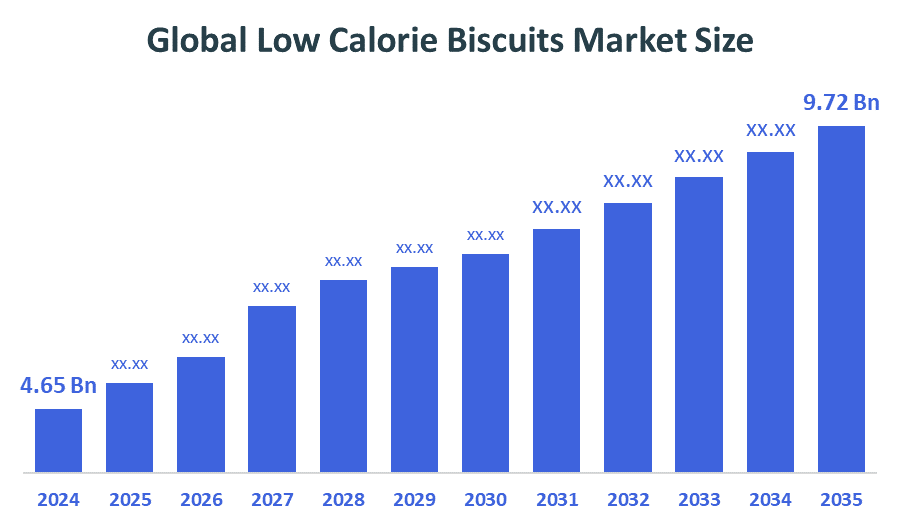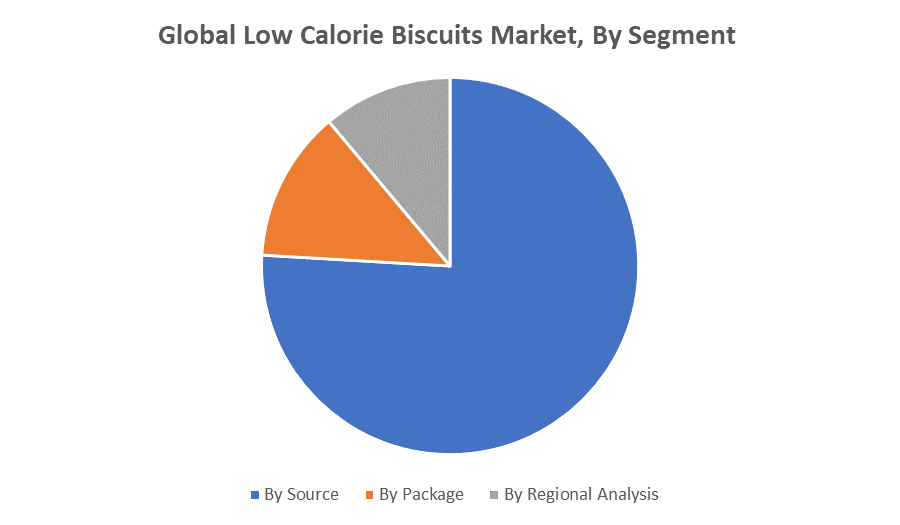Global Low Calorie Biscuits Market
Global Low Calorie Biscuits Market Size, Share, and COVID-19 Impact Analysis, By Source (Oats, Wheat, and Multi-grain), By Package (Packet and Box), and By Region (North America, Europe, Asia-Pacific, Latin America, Middle East, and Africa), Analysis and Forecast 2025 - 2035
Report Overview
Table of Contents
Global Low Calorie Biscuits Market Insights Forecasts to 2035
- The Global Low Calorie Biscuits Market Size Was Estimated at USD 4.65 Billion in 2024
- The Market Size is Expected to Grow at a CAGR of around 6.93% from 2025 to 2035
- The Worldwide Low Calorie Biscuits Market Size is Expected to Reach USD 9.72 Billion by 2035
- Asia Pacific is Expected to Grow the fastest during the forecast period.

Low Calorie Biscuits Market
The global low-calorie biscuits market is growing steadily as consumers increasingly seek healthier snack options. Low-calorie biscuits are designed to offer the taste and texture of traditional biscuits while reducing sugar, fat, and overall calorie content, making them suitable for weight management and healthier diets. Governments worldwide are supporting this trend through initiatives such as nutritional labeling requirements, sugar reduction policies, and public health campaigns aimed at combating obesity and promoting balanced diets. These efforts encourage food manufacturers to innovate and produce healthier products, including low-calorie biscuits. Market players focus on incorporating natural sweeteners, fiber, and whole grains to meet consumer demand for nutritious yet tasty snacks. Overall, the market is driven by rising health awareness and government policies promoting healthier eating habits, creating promising growth opportunities in the low-calorie biscuit segment.
Attractive Opportunities in the Low Calorie Biscuits Market
- Increasing consumer awareness about the benefits of low-calorie products is encouraging manufacturers to develop innovative biscuits with natural ingredients, added fibers, and vitamins. Expansion into e-commerce platforms and health-focused retail stores allows brands to reach a wider audience. This also includes targeting niche segments such as vegan, gluten-free, and diabetic-friendly biscuits, catering to specialized dietary needs and unlocking new consumer bases.
- There is strong potential to capitalize on growing demand for nutritious and functional snacks by incorporating natural sweeteners, fiber, whole grains, and added nutrients like protein or vitamins. Innovations such as AI-enabled personalized biscuit bundles or functional formulations (e.g., high-protein, high-fiber) enable brands to differentiate themselves and meet evolving consumer preferences, driving higher engagement and sales growth.
Global Low Calorie Biscuits Market Dynamics
DRIVER: Government initiatives promoting balanced diets
Consumers are actively seeking healthier snack alternatives with reduced sugar and fat content. Government initiatives promoting balanced diets and sugar reduction further encourage demand. Additionally, the surge in lifestyle-related diseases like diabetes fuels the preference for low-calorie foods. Innovations in food technology, such as natural sweeteners and high-fiber ingredients, enhance product appeal. Busy lifestyles also boost demand for convenient, guilt-free snacks. Together, these factors contribute to steady market expansion as consumers prioritize health without compromising on taste.
RESTRAINT: Higher production costs associated with healthier ingredients
The growth of the low-calorie biscuits market faces restraints such as higher production costs associated with healthier ingredients like natural sweeteners and fiber, which can lead to higher retail prices. Additionally, some consumers perceive low-calorie biscuits as less flavorful compared to traditional options, limiting repeat purchases. Limited awareness about the benefits of low-calorie products in certain regions also hinders market penetration. Furthermore, stringent regulations on food labeling and health claims can slow product launches. Lastly, competition from other healthy snack categories like protein bars and nuts diverts consumer spending, restricting the overall growth potential of low-calorie biscuits.
OPPORTUNITY: Expanding distribution channels
Increasing awareness about the benefits of low-calorie and sugar-free products encourages manufacturers to develop innovative biscuits with natural ingredients, added fibers, and vitamins. Expanding distribution channels, including e-commerce and health-focused retail stores, enable wider market reach. Collaborations between food companies and health organizations can boost consumer trust through verified health claims. Additionally, there is potential to tap into niche segments such as vegan, gluten-free, and diabetic-friendly biscuits, catering to specialized dietary needs. Emerging markets offer untapped consumer bases with growing health consciousness. Overall, innovation, product diversification, and strategic marketing present ample opportunities for brands to capture and expand their share in the evolving low-calorie biscuits market.
CHALLENGES: Strict regulatory requirements on health claims
The low-calorie biscuits market faces challenges like maintaining taste and texture while reducing calories, which can affect consumer acceptance. High production costs for healthier ingredients lead to higher prices, limiting affordability for some consumers. Strict regulatory requirements on health claims and labeling complicate product development and marketing. Additionally, intense competition from traditional snacks and other health-focused products makes market differentiation difficult. Limited consumer awareness in certain regions and skepticism about product benefits further hinder widespread adoption and market growth.
Global Low Calorie Biscuits Market Ecosystem Analysis
The global low-calorie biscuits market ecosystem includes raw material suppliers offering healthy ingredients like natural sweeteners and fibers, manufacturers focused on innovation, and regulatory bodies enforcing nutritional standards. Retail and e-commerce channels ensure wide product accessibility, while health-conscious consumers drive demand for functional and clean-label snacks. R&D and packaging partners support product quality and sustainability. This interconnected system enables continuous innovation, responding to rising health trends and regulatory pressures, ultimately shaping a competitive and evolving market focused on nutrition and consumer satisfaction.
Based on the source, the oats segment led the market with a significant revenue share over the forecast period
The oats segment indeed led the global low-calorie biscuits market with a significant revenue share during the forecast period. This dominance is attributed to oats' strong health appeal, including benefits like high fiber content, support for heart health, and ability to aid in weight management. Oat-based biscuits are widely perceived as a nutritious, filling, and low-calorie snack, making them especially popular among health-conscious consumers. Additionally, their versatility in formulations such as gluten-free or sugar-free variants further supports their leading position in the market.
Based on the package, the packet segment led the market with the highest market share over the forecast period
The packet segment led the global low-calorie biscuits market with the highest market share over the forecast period. This dominance is driven by increasing consumer preference for convenience, hygiene, and longer shelf life. Packaged biscuits are easier to store, carry, and consume on-the-go, aligning with the busy lifestyles of modern consumers. Additionally, attractive and informative packaging enhances brand visibility and helps communicate key health benefits, such as “low-calorie” or “sugar-free,” making packaged products more appealing and accessible in both retail and online channels.
Europe is anticipated to hold the largest market share of the low calorie biscuits market during the forecast period
Europe is anticipated to hold the largest market share of the low-calorie biscuits market during the forecast period. This growth is driven by rising health awareness, increasing demand for low-sugar and functional foods, and strong regulatory support for healthy eating. European consumers are highly conscious of product labeling and nutritional content, encouraging manufacturers to innovate with clean-label and diet-friendly biscuit options. Additionally, the region’s well-established retail infrastructure and widespread availability of premium health snacks further support the dominance of the low-calorie biscuit market in Europe.
Asia Pacific is expected to grow at the fastest CAGR in the low calorie biscuits market during the forecast period
Asia Pacific is expected to grow at the fastest CAGR in the low-calorie biscuits market during the forecast period. This rapid growth is fueled by rising health consciousness, increasing prevalence of lifestyle-related diseases like obesity and diabetes, and a growing demand for convenient, healthy snacks among the urban population. Expanding middle-class income, greater exposure to Western dietary trends, and the rapid growth of e-commerce and organized retail further support market expansion. Additionally, local and international brands are increasingly launching region-specific, low-calorie offerings, boosting consumer adoption across the region.
Recent Development
- In January 2025, Mondelez International launched a high-protein version of its belVita Breakfast Biscuits, specifically designed for health-conscious and fitness-oriented consumers. This new formulation is enriched with added protein to support muscle recovery and sustained energy release, making it suitable for active lifestyles and post-workout snacking. The launch represents Mondelez’s strategic move into the functional snacking segment, aligning with growing global demand for nutritious, on-the-go food options that offer both convenience and health benefits.
- In December 2024, Britannia Industries introduced a new high-fiber biscuit range, sold exclusively through Amazon and Flipkart. This launch was paired with an innovative AI-enabled personalization feature, allowing consumers to customize biscuit bundles based on their dietary preferences and snacking habits. Within just three months, the initiative led to a 23% increase in online sales, highlighting the growing impact of e-commerce platforms and personalized nutrition in driving consumer engagement and brand growth in the healthy snacking segment.
Key Market Players
KEY PLAYERS IN THE LOW CALORIE BISCUITS MARKET INCLUDE
- Mondelez International
- Britannia Industries
- Nestlé S.A.
- Kellogg Company
- ITC Limited
- McVitie’s (part of Pladis Global)
- PepsiCo, Inc. (Quaker Oats)
- Parle Products Pvt. Ltd.
- Britannia Industries Limited
- Lotus Bakeries
- Others
Market Segment
This study forecasts revenue at global, regional, and country levels from 2020 to 2035. Decisions Advisors has segmented the low calorie biscuits market based on the below-mentioned segments:

Global Low Calorie Biscuits Market, By Source
- Oats
- Wheat
- Multi grain
Global Low Calorie Biscuits Market, By Package
- Packet
- Box
Global Low Calorie Biscuits Market, By Regional Analysis
- North America
- US
- Canada
- Mexico
- Europe
- Germany
- UK
- France
- Italy
- Spain
- Russia
- Rest of Europe
- Asia Pacific
- China
- Japan
- India
- South Korea
- Australia
Check Licence
Choose the plan that fits you best: Single User, Multi-User, or Enterprise solutions tailored for your needs.
We Have You Covered
- 24/7 Analyst Support
- Clients Across the Globe
- Tailored Insights
- Technology Tracking
- Competitive Intelligence
- Custom Research
- Syndicated Market Studies
- Market Overview
- Market Segmentation
- Growth Drivers
- Market Opportunities
- Regulatory Insights
- Innovation & Sustainability
Report Details
| Pages | 218 |
| Delivery | PDF & Excel via Email |
| Language | English |
| Release | Aug 2025 |
| Access | Download from this page |
